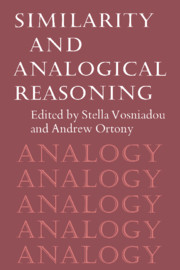Book contents
- Frontmatter
- Contents
- Preface
- List of contributors
- Similarity and analogical reasoning: a synthesis
- Part I Similarity and the structure of concepts
- Part II Analogical reasoning
- Part III Similarity and analogy in development, learning, and instruction
- Afterword: Comments on Parts I, II, and III: A framework for a theory of comparison and mapping
- Name index
- Subject index
Part III - Similarity and analogy in development, learning, and instruction
Published online by Cambridge University Press: 22 October 2009
- Frontmatter
- Contents
- Preface
- List of contributors
- Similarity and analogical reasoning: a synthesis
- Part I Similarity and the structure of concepts
- Part II Analogical reasoning
- Part III Similarity and analogy in development, learning, and instruction
- Afterword: Comments on Parts I, II, and III: A framework for a theory of comparison and mapping
- Name index
- Subject index
Summary
The contributions included in Part III focus on developmental and instructional aspects of similarity and analogy. In her chapter, Ann Brown argues that young children can transfer knowledge across analogous domains and that findings that they can not are an artifact of the paradigms used to assess transfer. Stella Vosniadou also argues that children are capable of using analogical reasoning to acquire new knowledge and that what develops is not analogical reasoning per se but the content and organization of the knowledge base to which analogical reasoning is applied.
Brian Ross discusses the role that remindings play in acquiring knowledge about unfamiliar domains and suggests using surface similarity as a way to enhance analogical access. In their contribution, John Bransford, Jeffery Franks, Nancy Vye, and Robert Sherwood offer several proposals about how to make the knowledge base more flexible. They suggest teaching people in problem-oriented environments, rather than teaching facts, and they mention various instructional techniques for promoting the noticing of similarities and differences. Rand Spiro, Paul Feltovich, Richard Coulson, and Daniel Anderson discuss the advantages and disadvantages of using instructional analogies to acquire knowledge in ill-structured domains. Finally, William Brewer offers a commentary on the contributions to Part III, focusing on the role of analogical reasoning in knowledge acquisition.
- Type
- Chapter
- Information
- Similarity and Analogical Reasoning , pp. 367 - 368Publisher: Cambridge University PressPrint publication year: 1989



